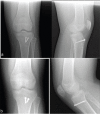Combined Tibial Tubercle Fracture and Patellar Tendon Avulsion: Surgical Technique and Case Report
- PMID: 30584509
- PMCID: PMC6298703
- DOI: 10.13107/jocr.2250-0685.1090
Combined Tibial Tubercle Fracture and Patellar Tendon Avulsion: Surgical Technique and Case Report
Abstract
Introduction: Isolated tibial tubercle fractures or patellar tendon ruptures are common injuries in adolescents. However, combined tubercle fractures with patellar tendon ruptures are rare, and hence, there are no definitive methods of surgical fixation or post-operative protocols.
Case report: A 13-year-old healthy girl sustained an extensor mechanism injury after the left knee hyperflexion during a fall from skateboarding. On examination, the extensor mechanism was not functional against gravity. Radiographic imaging revealed a displaced tibial tubercle fracture with patella alta, and magnetic resonance imaging revealed a concomitant patellar tendon avulsion from the tubercle. From a supine position on a radiolucent table, under general anesthesia and a femoral nerve block, the tibial tubercle fracture was fixed using two fully-threaded cortical screws. The patellar tendon was repaired with Fiber Wire through the Krakow method and secured through a tibial transosseous tunnel. A supplemental Fiber Wire was passed through a patellar tunnel and into a tibial tunnel to mitigate tension on the tendon repair. Post-operative knee motion was limited for 1 week to 60° of passive flexion, and full weight-bearing was permitted in a knee immobilizer.
Conclusion: Given the rarity of this combined extensor mechanism injury in adolescents and despite several different fixation methods reported in the literature, there is no clearly superior surgical technique. This case demonstrates a technique allowing for stability of the tubercle fracture and robust repair of the patellar tendon that permits early range of motion and weight-bearing.
Keywords: Tibial tubercle fracture; patellar tendon avulsion; surgery; technique.
Conflict of interest statement
Conflict of Interest: Nil
Figures





References
-
- Hamilton SW, Gibson PH. Simultaneous bilateral avulsion fractures of the tibial tuberosity in adolescence:A case report and a review of over 50 years of literature. Knee. 2006;13:404–7. - PubMed
-
- Clarke DO, Franklin SA, Wright DE. Avulsion fracture of the tibial tubercle associated with patellar tendon avulsion. Orthopedics. 2016;39:e561–4. - PubMed
-
- Frankl U, Wasilewski SA, Healy WL. Avulsion fracture of the tibial tubercle with avulsion of the patellar ligament. Report of two cases. J Bone Joint Surg Am. 1990;72:1411–3. - PubMed
-
- Goodier D, Maffulli N, Good CJ. Tibial tuberosity avulsion associated with patellar tendon avulsion. Acta Orthop Belg. 1994;60:336–8. - PubMed
Publication types
LinkOut - more resources
Full Text Sources
